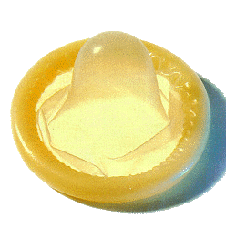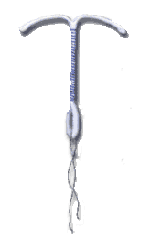
Home |
Up |
Prev |
Next |



"The Pill", a condom and an IUD.
Why Contraception?
The Church of Infinite Dimensions celebrates joyful sexual congress, it also celebrates the birth of wanted children. It does not however, believe that sexual consummation should necessarily lead to children, nor does it believe that it is in the best interests of all that unwanted children should be born. To prevent the arrival of unwanted children following heterosexual intercourse requires either contraception or abortion. The Church believes that abortion should be used only as a last resort and strongly supports the use of contraceptive devices by all that are sexually active, fertile and not wanting more children at the time.
Contraception may be practiced by the male or the female. At present, most devices are designed for the woman. This is a corollary of the woman having the womb:
- The woman is the one who would be responsible for any child resulting, therefore has the greatest desire to prevent it, and is the one most prepared to take the necessary action. Hence the one that the companies will market to.
- There are more places in the process of reproduction for contraception to occur in the woman than the man, hence the proliferation of devices.
This does not mean that the Church prefers that women bear the burden of contraception, far from it, the Church believes that the method of contraception should be tailored to the individual situation, and that the method that affords the simplest, most reliable effect with the least side effects should be chosen.
Methods Of Contraception
Essentially there are two approaches to contraception: physical and chemical. The physical approach tends to have few side effects but may be inconvenient. The chemical approach tends to have significant side effects but may be more convenient. Both approaches have methods that are reliable to a greater or lesser extent.
To avoid conception the fertilisation of the female's egg by the male's sperm must be prevented. This may be done by:
- Preventing the production of sperm.
- Preventing the production of eggs.
- Preventing the delivery of sperm to the penis.
- Preventing the delivery of eggs to the uterus.
- Preventing sperm entering the vagina.
- Preventing sperm entering the uterus.
- Killing sperm in the vagina.
- Only having sex when there is no egg present.
- Killing sperm and/or eggs in the uterus.
Then there are techniques that are technically abortion, but because they occur so close to the point of conception they are best considered as contraceptives:
- Preventing a newly fertilised egg from attaching itself to the uterine wall.
- Removing a newly implanted egg from the uterine wall.
Each of these classes of contraceptive may have multiple means of achieving that goal so the number and names of them can be quite bewildering and quality education in these matters is called for, for all people at puberty and beyond. The correct forum for this education is secondary school.
Preventing the production of sperm.
The simplest method of achieving this is to remove the testicles. This is known as Castration, it is 100% effective and commonly used on farm animals. Unfortunately it is irreversible and has serious side effects. The process calls for the removal of the glands producing testosterone, without which the male loses much of his male character. The Church regards this technique as unacceptable as a means of contraception.
Chemical means may also be used to prevent the testicles producing viable sperm, but such methods are likely to have side effects and may not be reliable.
Preventing the production of eggs.
The simplest method of achieving this is to remove the ovaries. This is the female equivalent of castration and similarly is 100% effective, is irreversible and has serious side effects. The removal of the ovaries calls for the removal of the glands producing estrogen and progesterone, without which the female loses most of her feminine character. The Church regards this technique as unacceptable as a means of contraception.
Egg production may also be prevented by controlling the levels of ovarian hormones in the blood so that the pituitary gland fails to instruct the ovaries to release an egg. The levels may be controlled by a pill taken orally (The Pill), by an external skin patch, by injection or by slow release implant.
If both hormones are controlled this means of contraception is very reliable and for this reason is extremely common today. If only progesterone is controlled the action is less so, though still relatively good.
The problem with contraception by hormonal control is that it has strong side effects. Commonly mentioned effects may include: weight gain, nausea, vaginal infections, acne, increased blood pressure, headaches and reduced libido. Less commonly mentioned but far more insidious is the effect on the character of the woman. The woman becomes less loving, less desirable, less lively and less fun to be with.
This destruction of much of the character of the female is perhaps, no better than that of ovarian removal. The only advantage is that it is temporary. The Church is happy to countenance its use so long as it is only temporary. That a woman should suffer these side effects and lose much of her character for all of her fertile life is unacceptable.
Preventing the delivery of sperm to the penis.
This is done by severing or blocking the sperm duct or vas deferens between the testicles and the prostate gland. The procedure is known as a Vasectomy. If the duct is properly severed and tied off the procedure is extremely reliable as a contraceptive. The procedure is relatively simple and may be performed under local anaesthetic in 20 minutes or so.
Various measures may be taken to ensure that there is no possibility of recanalisation, such as cutting a length out of the duct, cauterisation of the ends, tying the ends and separating the ends with testicular tissue. Each of these increase the reliability of the procedure but increase the pain and recovery time and reduce the possibility of reversal.
The operation may be very painful for a week or more in many cases and the man may feel that his testes don't feel quite right for a year or more afterwards, however this is unlikely to be bad enough to be significant. All the normal hormonal levels and sexual function remain as before and the man continues to ejaculate semen although it no longer contains sperm. It is thus fair to say that this means of contraception has no side effects. For this reason the Church regards this as the best long-term contraceptive.
The only real problem with this technique is that it may not be reversible. For this reason it should only be used by men who are certain that they don't want any more children.
There is also the bizarre practice of Penile Subincision, as employed by various tribal cultures, where the urethra is split open down to the scrotum so that the semen no longer shoots out of the head of the penis, but instead emerges from the scrotum. This affords the male some measure of control over where his semen ends up.
Aside from the mutilation aspect of the male's natural form, the efficacy of this method is likely to be rather variable due to the ability of sperm to travel. This technique is thus not entirely reliable as a means of contraception. The modification of the penis is also irreversible, which may be a real problem if a couple wish to produce children.
Preventing the delivery of eggs to the uterus.
This done by severing or blocking the fallopian tube before it joins the uterus. It is the female equivalent of a vasectomy and is often known as Tubal Ligation. Because the fallopian tubes are embedded deep in the abdominal cavity however, the operation to cut and tie them is far more tricky and more likely to lead to complications than is the case with a vasectomy.
Provided the procedure goes according to plan it is highly effective as a contraceptive. However, because the procedure is more difficult than in the male there is a greater probability that the wrong tube may be cut or not tied correctly and there is a slight risk following normal sex of either a conventional or ectopic pregnancy.
As is the case with vasectomy there are no real side effects and for this reason the Church regards it as a suitable long-term contraceptive. The procedure is not generally reversible however and for this reason should only be used by women who are certain that they don't want any more children.
Preventing sperm entering the vagina.
This may be done by ejaculating outside the vagina (Withdrawal or Non-coital Sex), not having sex at all (Abstinence), or by placing a bag around the penis to hold the semen (Condom).
Abstinence is guaranteed 100% effective but is not good for a loving relationship. Nor is it good for the mental health of those practicing it. For this reason the Church is against it.
Non-coital sex uses techniques such as masturbation, oral sex and anal sex to achieve orgasm. These techniques may be felt to leave something lacking but they are certainly far more satisfying than abstinence. They are however, not necessarily 100% effective in preventing conception. Unless the couple are rigorous about sterile handling, semen may be transmitted through hands or bodily fluids and may on occasion be able to wriggle into the uterus after all.
The withdrawal method involves the couple engaging in normal intercourse until the male feels that he is about to cum, whereupon he withdraws his penis and shoots his load onto the woman's belly or breasts. This method is notoriously unreliable as it requires great discipline and technique on the part of the man which may slip on occasion, and also because small quantities of sperm may emerge from the penis before ejaculation initiating conception regardless. It is not recommended as a serious method.
The condom method involves unrolling a latex bag along the length of the penile shaft with an extra space at the tip to trap the ejaculate. Ideally the condom fits snugly against the shaft and stays on until after ejaculation and withdrawal, whereupon it is tied off and discarded. Although a very common method of contraception it is fraught with difficulties:
Because the condom must be rolled onto an erect penis, it interrupts the process of lovemaking and many men, especially the inexperienced and marginally potent, may find they lose their erection.
It is quite common for the condom to move on the shaft during intercourse and it may become partially or fully dislodged, reducing or completely negating its efficacy as a contraceptive. On some occasions the man may not be aware that the condom has come off.
Although the rubber is thin it nonetheless reduces the sensation and hence the pleasure of intercourse.
The condom is notoriously unreliable as a contraceptive, and even in skilled hands it should not be used as a long-term solution.
Preventing sperm entering the uterus.
This is done by placing a physical barrier across the cervix which is the gateway to the uterus. Two devices exist at present: the Diaphragm and the Cervical Cap. Both are used in conjunction with a spermicide and must be left in place until all the sperm are dead.
Although they have no side effects they are something of a pest and they are not entirely reliable.
Even less reliable is the Rinsing Out method where the vagina is rinsed or washed out after the man has ejaculated within it.
Killing sperm in the vagina.
This is done with some form of Spermicide, a foam, cream or jelly that is inserted into the vagina prior to intercourse.
Because it must be applied shortly before intercourse it tends to interrupt the natural flow of lovemaking, furthermore it may cause irritation to the vagina and lastly it doesn't work very well on its own. For this reason it is generally used in conjunction with a diaphragm or condom.
Only having sex when there is no egg present.
This is commonly known as the Rhythm Method. It would be an excellent method for those who don't mind missing out on sex for a week or so every month EXCEPT that there is currently no sure way of knowing whether there is an egg present or not.
The egg does not always come and go as expected and thus this method is currently unreliable. It should only be used by couples who would not be unhappy with a pregnancy.
Killing sperm and/or eggs in the uterus.
This is currently done using a device known as an IUD or Intra-Uterine Device. This is a T shaped object placed inside the womb that slowly secretes a chemical, (usually copper or a progestin), that prevents pregnancy by killing sperm and/or eggs either directly or indirectly, or by preventing sperm reaching or fertilising the egg, or by preventing the egg from implanting itself in the uterine wall.
Modern IUDs may be left in the womb for 5 years or more, and if the string is checked regularly are very effective as a contraceptive.
The device is more likely to fall out in women that have not had a child. There is some risk of Pelvic Inflammatory Disease especially in the first month after insertion. There is a slight risk of perforation of the uterus during insertion.
Although they acquired a bad reputation in the 1970s, recent evidence on modern IUDs shows that they are reasonably safe, very reliable, cheap, reversible and have few side effects. Everything the Church wishes. They may not however be suitable for all women and should be fitted by an expert.
Removing a newly fertilised egg from the uterine wall or preventing it attaching.
This is usually done a day or so after unprotected sex, when the woman believes an egg may have been fertilised and wishes to prevent pregnancy. It is usually done with a strong dose of female hormones taken orally, known as the Morning After Pill or Emergency Contraception.
The hormones disrupt the uterine lining and also act to prevent conception if it has not already happened.
It is not always effective but worth a try in an emergency.
Interestingly, a more reliable means of after-the-fact contraception is the insertion of a copper IUD which is almost certain to prevent any pregnancy.
The Ideal Method
Sadly there is no ideal method of contraception; no 100% reliable, reversible technique with no side effects and no drawbacks.
Should it exist, an ideal method might be: a valve implanted in the gamete delivery tube at puberty, that may be operated from the outside to turn fertility on or off at will. It would mesh neatly with the existing tissue and not be rejected, wear out, leak or jam. Now THAT, I think is worth some research.
Sexually Transmissible Disease
This sermon is not on the topic of Sexually Transmissible Diseases (STDs), so I will not say much on the subject, merely that these pathogens, like any other, should be killed if possible and not transmitted to clean hosts.
Certain methods of contraception are often used to prevent the transmission of STDs, for example condoms are widely promoted as a means to prevent infection by the AIDs virus. This is all very well if the parties are happy to use the devices, but such devices may fail on occasion to prevent infection, just as they may fail to prevent conception.
The best means of protection against STDs is to know that the parties to intercourse are not carriers. This may be done by attending a VD clinic together for a checkup prior to intercourse. Once the parties have been declared clean they should stay that way and will not require protection from STDs so long as they don't engage in sex outside the union. For this reason promiscuity should be eschewed by those wishing to avoid STDs.
Conclusion
The Church Of Infinite Dimensions sees contraception as a necessary and appropriate part of contemporary life and advocates the comprehensive education in their properties and usage and the research into better forms.
The Church prefers physical methods of contraception over the hormonal, especially in the long term, because of the side effects of the hormonal approach.
With the techniques currently available the Church considers:
- vasectomy the best long-term method for couples that are sure they have had all the children they want.
- the oral pill the best medium term solution for young women.
- an IUD the best long-term solution for women who may want more children.
- non-coital sex the best short term solution for couples waiting to start another method.
Condoms, creams and diaphragms are a pest and not reliable for the long term.
The rhythm method, withdrawal, or rinsing out the vagina afterwards are not reliable even in the medium term.
Finally, remember: there is NOT yet any perfectly satisfactory method of contraception for young adults.